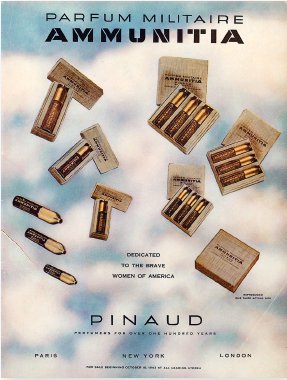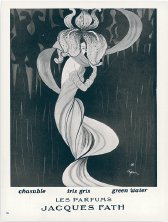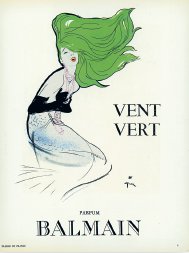Scent and Subversion (12 page)
Read Scent and Subversion Online
Authors: Barbara Herman

by Robert Piguet (1945)
Perfumer:
Jean Carles
There was a little mix-up years ago when I began to collect and write about vintage. I thought I’d ordered vintage Visa, not realizing there was a reissue, and I was baffled as to how on earth a vintage perfume could smell like Thierry Mugler’s Angel. I finally figured it out, got the vintage perfume, and I now realize the two are so different they should be on different planets.
Vintage Visa is a deeply erotic rose scent with a fatty, voluptuous base of Animalis (also in Baghari) and perhaps woods, spice (carnation? cinnamon?), and leather. Leave it to “the whore’s perfumer” (there, I said it!) to make rose, a usually demure floral with a good, old-fashioned reputation, into Rose Red with a Scarlet A on her too-low-cut dress. There’s almost a wine-like element to Visa’s rose, but it’s dancing very closely to Animalis. What any of this sexiness has to do with Visa and air travel is anyone’s guess!
Notes:
Aldehydes, rose, florals, and, according to Denyse Beaulieu of the blog, Grain de Musc, Animalis by Synarome. (Animalis was a perfume base with a mix of animal notes: civet, musk, castoreum, and the animalic costus, a plant-based ingredient that’s been described as smelling like wet animal fur or the sebum from unwashed hair.)
by Nina Ricci (1946)
Perfumer:
Germaine Cellier
When Germaine Cellier does butch, she does butch, and when she does femme, like Fracas and Fleeting Moment, they’re practically in drag. Coeur-Joie (“Joyful Heart”), however, pulls out all the stops. Where Fracas is still a naughty and provocative tuberose, and Fleeting Moment a little inward and reserved, Coeur-Joie, like its bitter-green counterpart Vent Vert, throws open the window and squeezes the beauty out of every floral it touches. Coeur-Joie’s powdery sweetness lifts everything up into a chorus of flowers followed by a warm and buttery base.
Notes from
1964 Dictionnaire des Parfums de France:
“A citrusy floral featuring jasmine absolute, violet absolute, iris (from Provence), rose (from the Orient), neroli, acetivenol, and aldehydes.”
by Carven (1946)
Perfumer:
Jean Carles
Composed by a perfumer who had become anosmic (unable to smell), Ma Griffe is nevertheless a more-wearable Bandit or Cabochard, in spite of opening with the magnificently bitter galbanum note. The opening aldehydes will knock you down, but the cinnamon and gardenia will cushion your fall. Many a perfumista has mentioned that her grandmother has tagged Ma Griffe as “the prostitute’s perfume.” I think what they really mean is that it’s the perfume of a woman doesn’t give a damn.
Bright, green, comforting, and yet slightly dangerous—the comfort and the danger, I think, come from the same source: cinnamon—this is one of those fragrances that shouldn’t work, but does. Perhaps I’m reading into this after the fact, but although Carles composed this from his scent memory, it does give one the impression of a perfume based on cerebral abstraction rather than sensual experience.
Top notes:
Aldehydes, clary sage, galbanum, bergamot
Heart notes:
Gardenia, jasmine, ylang-ylang, rose
Base notes:
Cinnamon, tonka bean, vetiver

This World War II–era ad from 1943 touts Pinaud’s bullet-shaped perfume Ammunitia as a military perfume (
parfum militaire
) that is “[d] edicated to the brave women of America.”
by Jean d’Albret (1947)
Aldehydic floral Écusson (“Emblem”) distinguishes itself from the well-heeled pack of this category by being quickly and insistently sensuous, animalic, and erotic in the base. This perfume told me, before I even looked at its notes, that it contained civet and nitromusks. A delicate cinnamon spice bridges its girlish flowers from its sensuous base. Écusson is a study in the way a perfumer can add depth to lightness without any appreciable caloric difference.
Top notes:
Aldehyde complex, bergamot, orange blossom, peach, strawberry
Heart notes:
Jasmine, rose, narcissus, ylang-ylang, orris
Base notes:
Sandalwood, musk, cinnamon, civet, benzoin, cistus, tonka
by Caron (1947)
Perfumer:
Michel Morsetti
An almondy richness reminiscent of heliotrope radiates from the center of Farnesiana, named after the powdery-sweet blooms of the
Acacia farnesiana,
or mimosa tree. Its violet and lilac heart gives the impression that Farnesiana is a floral confection wrapped in a diaphanous veil of sweet, powdery paper. An anise aftertaste underlies its candylike yet sophisticated sweetness, followed by subtle spice and woods. Unmistakably vintage, multilayered, and beautiful.
Top notes:
Cassie, mimosa, bergamot
Heart notes:
Jasmine, violet, lily of the valley, lilac
Base notes:
Opopanax, vanilla, sandalwood, hay, musk
by Jacques Fath (1947)

In this 1949 ad, artist René Gruau turns a woman’s body into the stem of the iris flower, from whose roots come the powdery, buttery orris note that is the centerpiece of this legendary perfume.
Perfumer:
Vincent Roubert
If you’ve ever smelled orris butter, made from the dried roots of the iris flower, you can appreciate how faithful to that sumptuous note Iris Gris is, adorning it minimally to enhance its waxy richness while adding the delicate, milky peach note, Persicol. Peach-scented pastry dough, an oft-used description, is probably the most accurate description of this perfume.
Iris Gris starts out spicy sharp and moves into a smooth, buttery peachy richness, which gives Iris Gris a girlish lightness. It is oily and rich, but rich in the way a stone fruit mixed with cream is both aromatically fresh and rich. It provides the olfactory equivalent of “mouth feel,” a foodie reference describing the tactile pleasure of having something rich in one’s mouth.
Notes from
Octavian Coifan:
Delta-undecalactone (Persicol), orris, cedar, vetiver, jasmine, lily of the valley, heliotrope, lilac, musk
by Balenciaga (1947)
Perfumer:
Francis Fabron
Often described as Chanel No. 5 with violets, Le Dix (“The 10”), with its nose-tickling aldehydic sparkle and haunting violet note, holds its head up high among vintage perfumes, like a handsome older woman in a sturdy 1940s suit, hat, and full makeup standing in a sea of Forever 21–clad teenagers. She has to be proud; everyone is telling her she smells “powdery,” “old,” and “soapy.”
Its initial impression of softness and conventional femininity is bound up with a perfume note that has perhaps always signified nostalgia and melancholy: violet. Le Dix is faithful to the melancholy connotations of violet but adds gourmand richness to round it out, and a spicy/woody backbone and the fatty, burnt-caramel note of nitromusks to give it some edge.
I can detect Francis Fabron’s authorial signature in the final stages of Le Dix’s drydown. He’s the nose of one of my favorite perfumes, Robert Piguet’s Baghari. In Baghari’s drydown, there is an absolutely heady and intoxicating richness (courtesy of a boozy-creamy balsamic plus Animalis base) that makes me make swoon. Although Le Dix’s drydown is powdery and gentler, it still packs a punch. (Baghari and Le Dix have the following notes in common: aldehydes, bergamot, lemon; ylang-ylang, rose, lily of the valley; and vetiver, musk, and vanilla.)
Top notes:
Bergamot, lemon
Heart notes:
Ylang-ylang, rose, lily of the valley, iris (definitely violet, but not listed)
Base notes:
Civet, musk, vanilla, sandalwood, vetiver
by Christian Dior (1947)
Perfumers:
Jean Carles and Paul Vacher
Miss Dior exemplifies a perfume for the late-1940s woman whose sexuality was, perhaps, under wraps. The first time I smelled it, I detected an animalic note, strangely enough, before I smelled its lushly floral bouquet, the animal dirtiness before the ladylike polish.
But when the flowers do hit—wow. Bruised flowers on a base of leather, moss, and patchouli, sliced with something sharp and green to cut through the lushness and make it sing, the way lemon zest can make a creamy risotto even more delicious. Although this is not a Guerlain, Miss Dior seems to be operating under Jacques Guerlain’s olfactory principle: “Perfume should smell like the underside of my mistress.” It’s said that
when Christian Dior debuted his revolutionary “New Look” on February 12, 1947, the runways were also scented with his new perfume, Miss Dior.
Top notes:
Gardenia, galbanum, clary sage (sauge sclarée), aldehydes
Heart notes:
Jasmine, rose, neroli, narcissus, iris, eyelet, lily of the valley
Base notes:
Patchouli, cistus-labdanum, oakmoss, ambergris, sandalwood, vetiver, leather (Cuir de Russie)
by Carven (1947)
Sensual and elegant perfumes are often pitted against each other, as if one precludes the other. But Carven’s Robe d’un Soir (“Evening Gown”) proves that a perfume can be both, with its balance of fresh top notes, classical florals, and a sensual base that’s a balance of woods and creamy balsam notes.
This sensual, powdery rose scent marries a Rose de Mai as its queen to the powdery warmth and sensuality of orris and carnation, and a base that is by turns creamy and woody. Like an evening gown, the balance is what makes it special. Sexiness with elegance, skin with structure, voluptuousness with reserve.
Top notes:
Bergamot, aldehyde complex, neroli, peach, mandarin
Heart notes:
Rose, jasmine, ylang-ylang, carnation, orris, lilac
Base notes:
Vetiver, amber, cedarwood, vanilla, sandalwood, benzoin
by Balmain (1947)

With its famous overdose of the ingredient galbanum, which imparts a bitter-green freshness to scents, Vent Vert is herbs, bent stems, and roses. In this advertisement, renowned fashion illustrator René Gruau expresses the perfume’s wild beauty by drawing a laughing woman with flowing green hair. (Ad from 1949)
Perfumer:
Germaine Cellier
Composed by the amazing Germaine Cellier, Vent Vert (“Green Wind”) is a synesthete’s dream: It smells like the color green. It sounds off with a bitter, verdant blast of galbanum
like a trumpet’s call, and shortly thereafter other flower notes run and swirl onto the stage like ballet dancers in a production of Nijinsky’s paganistic
The Rite of Spring.